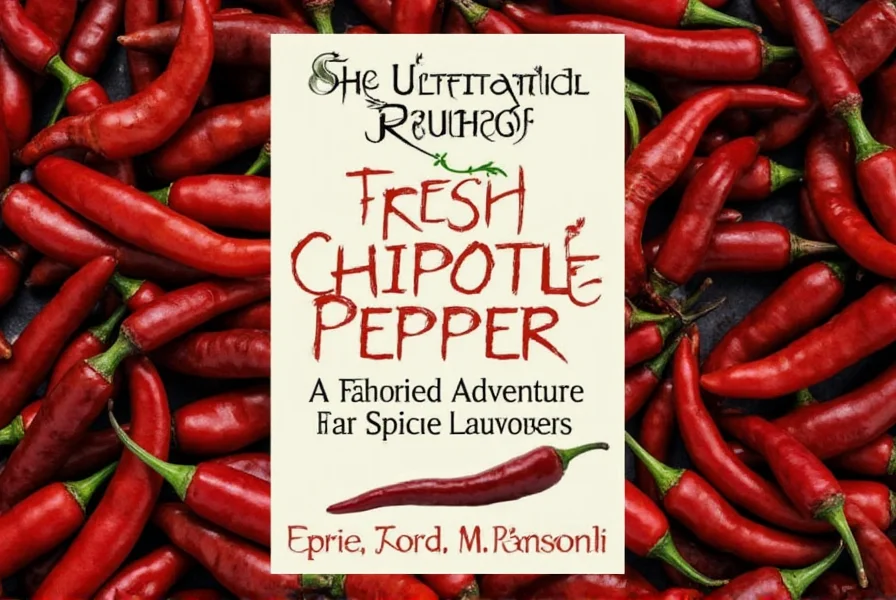Table of Contents
Introduction
Contrary to popular belief, there is no such thing as a "fresh chipotle pepper." Chipotle peppers are specifically jalapeños that have been smoked and dried. Fresh jalapeños are the raw form, and when they undergo the smoking process, they become chipotles. This guide clarifies common misconceptions and provides accurate information on using chipotle peppers in your cooking.
What Are Chipotle Peppers?
Chipotle peppers are mature jalapeños that have been smoke-dried. The term "chipotle" originates from the Nahuatl word "chilpoctli," meaning "smoked chili." Unlike fresh jalapeños, chipotles have a deep reddish-brown color, leathery texture, and concentrated smoky flavor. They typically range from 2,500–8,000 Scoville units, similar to jalapeños, but the smoking process intensifies their heat and adds complex earthy notes.
Flavor Profile and Culinary Uses
Chipotle peppers deliver a unique combination of smokiness, sweetness, and moderate heat. Their dried form makes them ideal for slow-cooked dishes where the smoky flavor can develop fully. Here are common culinary applications:
- Salsas: Rehydrate dried chipotles and blend with tomatoes, onions, and lime for smoky salsa.
- Mole: Essential for authentic Mexican mole sauces, providing depth and complexity.
- Marinades: Add ground chipotle to meat marinades for a rich, smoky kick.
- Barbecue Sauces: Infuse chipotle into sauces for a signature smoky heat.
- Stews and Soups: Use whole or powdered chipotles to enhance savory dishes.
How to Buy Chipotle Peppers
Since chipotles are always dried or smoked, look for these quality indicators:
Appearance
Choose peppers with a deep reddish-brown color, uniform texture, and no mold or excessive moisture. Avoid overly brittle or discolored pieces.
Smell
Fresh chipotles should have a rich, smoky aroma. Avoid any with musty or sour odors.
Form Options
Chipotles are available in multiple forms:
- Whole dried peppers: Best for rehydrating in sauces or grinding fresh.
- Chipotle powder: Convenient for seasoning meats or dry rubs.
- Chipotle in adobo sauce: Ready-to-use canned peppers in a tangy tomato-based sauce.
Cooking Tips and Techniques
Rehydrating Dried Chipotles
Soak dried chipotles in hot water for 15-20 minutes until soft. Remove stems and seeds before blending for sauces.
Grinding Whole Peppers
Use a spice grinder to create fresh chipotle powder. Store in an airtight container away from light.
Using Adobo Sauce
Blend canned chipotles in adobo with the sauce for instant smoky flavor in salsas, dressings, or marinades.
Common Mistakes to Avoid
- Confusing fresh jalapeños with chipotles: Fresh jalapeños lack smokiness; use them only for raw applications like salsas or garnishes.
- Overusing chipotles: Start with 1-2 peppers per recipe and adjust gradually—their heat intensifies during cooking.
- Ignoring seed removal: Seeds contain most of the heat. Remove them for milder dishes.
- Storing improperly: Keep dried chipotles in a cool, dark place. Refrigerate opened adobo sauce containers.
Frequently Asked Questions (FAQ)
What exactly are chipotle peppers?
Chipotle peppers are smoked and dried jalapeños. The term "chipotle" refers exclusively to the dried/smoked form. There is no such thing as a "fresh chipotle pepper."
How do chipotle peppers differ from fresh jalapeños?
Chipotles are dried and smoked jalapeños with concentrated smokiness and heat. Fresh jalapeños are crisp, grassy, and lack the smoky depth. Chipotles are used in cooked dishes, while fresh jalapeños work best raw or lightly cooked.
Can I substitute fresh jalapeños for chipotles?
Yes, but you'll miss the smoky flavor. To compensate, add 1/4 teaspoon smoked paprika per fresh jalapeño. For heat adjustment, use 1 fresh jalapeño for every 1 dried chipotle pepper.
How long do dried chipotle peppers last?
Properly stored in an airtight container away from light, dried chipotles retain quality for 1-2 years. Canned chipotles in adobo last 1-2 months refrigerated after opening.
Why are chipotles called "chipotle" if they're dried?
The term comes from Nahuatl "chilpoctli" (smoked chili). All chipotles are dried/smoked by definition—there is no fresh version of the term.
How can I reduce heat when using chipotles?
Remove seeds and inner membranes before use. Soak dried chipotles in milk for 10 minutes to neutralize capsaicin. Always wear gloves when handling to prevent skin irritation.
Buying Guide: Top Chipotle Products
Chipotle peppers are always sold in dried or processed forms. Here are the best options:
1. Dried Whole Chipotle Peppers
Features: Unprocessed, smoke-dried jalapeños with natural texture.
Advantages: Maximum flavor control; ideal for grinding or rehydrating.
Use Cases: Homemade salsas, moles, and spice blends.
Target Audience: Serious cooks and traditional Mexican cuisine enthusiasts.
2. Chipotle Powder
Features: Finely ground dried chipotles for instant use.
Advantages: Consistent flavor; no preparation needed.
Use Cases: Dry rubs, seasoning meats, or adding to soups.
Target Audience: Busy home cooks and spice enthusiasts.
3. Chipotle in Adobo Sauce
Features: Canned chipotles preserved in tangy tomato-based sauce.
Advantages: Ready-to-use; adds both smokiness and acidity.
Use Cases: Quick marinades, sauces, or dressings.
Target Audience: Casual cooks and recipe beginners.

Conclusion
Chipotle peppers are always dried and smoked jalapeños—there is no fresh version. Understanding this distinction is key to using them effectively in cooking. Their smoky depth transforms dishes when used correctly, but confusion about their nature leads to common mistakes. By choosing the right form (whole, powder, or adobo), handling them properly, and respecting their heat level, you can unlock their full potential in any kitchen.
Remember: Always verify product labels for authenticity. True chipotles will specify "smoked and dried jalapeños"—avoid any product claiming to be "fresh chipotle peppers."











 浙公网安备
33010002000092号
浙公网安备
33010002000092号 浙B2-20120091-4
浙B2-20120091-4